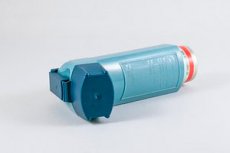Medical expert of the article
New publications
Bronchobstructive syndrome
Last reviewed: 05.07.2025

All iLive content is medically reviewed or fact checked to ensure as much factual accuracy as possible.
We have strict sourcing guidelines and only link to reputable media sites, academic research institutions and, whenever possible, medically peer reviewed studies. Note that the numbers in parentheses ([1], [2], etc.) are clickable links to these studies.
If you feel that any of our content is inaccurate, out-of-date, or otherwise questionable, please select it and press Ctrl + Enter.

One of the clearly defined clinical manifestations of acute respiratory failure of the ventilation type is broncho-obstructive syndrome, in the pathogenesis of which the leading role is played by spasm of small bronchi in combination with edema of their mucous membrane and hypersecretion of sputum.
Causes of broncho-obstructive syndrome
Broncho-obstructive syndrome develops as a result of viral inflammation of the bronchial mucosa with a clinical picture of bronchiolitis in children of the first months of life and obstructive bronchitis in older children. A clinical example of allergic inflammation of the bronchial mucosa, accompanied by broncho-obstructive syndrome, is bronchial asthma, which usually develops in children over 3 years old, but its cases have also been described in infancy.
Broncho-obstructive syndrome most often occurs in young children, and particularly severe forms (bronchiolitis) are observed in the first months of life against the background of RS infection. Broncho-obstructive syndrome can also develop with other acute respiratory viral infections (with influenza).
How does broncho-obstructive syndrome manifest itself?
Symptoms of broncho-obstructive syndrome include expiratory dyspnea (prolonged exhalation time), the appearance of dry, wheezing rales in the lungs, heard symmetrically in the inter- and subscapular space.
Percussion of the chest reveals a box-shaped sound as a result of acute emphysema and expiratory closure of the bronchioles. Radiographically, an increase in the pulmonary pattern and expansion of the roots of the lungs against the background of their emphysematous swelling are revealed.
Treatment of broncho-obstructive syndrome
The principles of treatment of broncho-obstructive syndrome are as follows:
- relief of bronchospasm with theophylline preparations (euphyllin, aminophylline, etc.) and modern selective inhalation sympathomimetics (salbutamol, fenoterol, etc.). In young children, nebulizer therapy with selective bronchodilators is effective. To stop an attack of bronchial asthma, the following scheme is usually used: 1-2 inhalations from standard inhalers, repeated after 5-10 minutes until clinical improvement is achieved (no more than 10 inhalations). If the patient feels better, repeat inhalations are carried out after 3-4 hours;
- improving the drainage function of the bronchi and the rheological properties of sputum, for which the following are used:
- restoration of VEO by intravenous fluid administration or intravenous infusion of saline solution;
- humidification of inhaled air using ultrasonic inhalation devices and nebulization of saline solution;
- prescribing drugs that stimulate and relieve cough (mucolytics, ciliokinetics);
- vigorous chest massage after inhalation of saline or bronchodilators (especially useful in children with bronchiolitis);
- etiotropic treatment: antiviral (ribavirin, RNase, DNAase, etc.) and immune drugs for severe forms of viral OS, antibiotics if the bacterial nature of the disease is suspected or if bacterial complications develop;
- in severe OS and ARF grades II-III, resort to short courses (1-5 days) of prednisolone therapy (daily dose 1-2 mg/kg);
- Oxygen therapy is indicated for all forms of OS, however, prolonged use of high concentrations (> 60 vol.%) should be avoided;
- Severe broncho-obstructive syndrome, especially in children in the first months of life, may be accompanied by severe hypoxemia, which serves as a basis for respiratory support; artificial ventilation is carried out in a moderate hyperventilation mode with the selection of the inhalation-exhalation time ratio (1:E = from 1:3 to 1:1 or 2:1) and mandatory synchronization of the patient and the artificial ventilation apparatus using diazepam, GHB.


 [
[